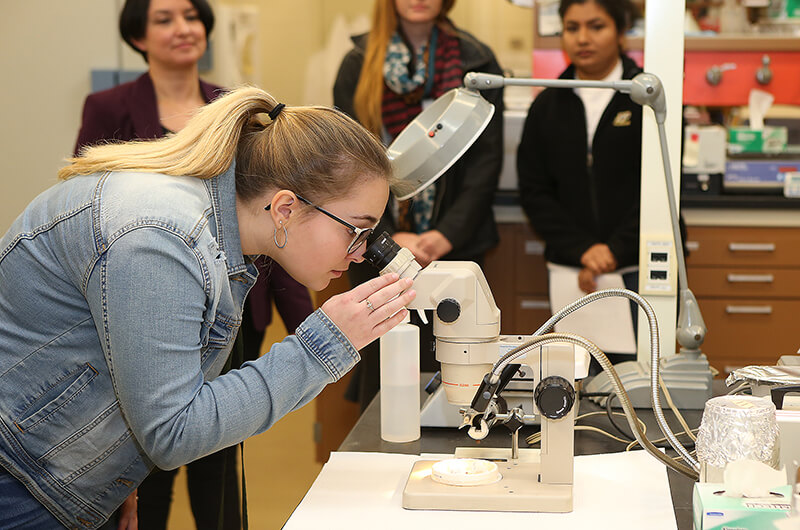October 24, 2018
Scientists, high school students find new pathogens hiding in Indiana ticks
 Lisa Cunningham, of Switzerland County High School, examines a tick under a microscope as part of a campus visit for the Tick INsider program. More than a dozen Indiana high school students are trained to collect ticks around the state so that Purdue scientists can analyze them and map the pathogens present in the state's tick population. (Purdue Agricultural Communication photo/Tom Campbell)
Download image
Lisa Cunningham, of Switzerland County High School, examines a tick under a microscope as part of a campus visit for the Tick INsider program. More than a dozen Indiana high school students are trained to collect ticks around the state so that Purdue scientists can analyze them and map the pathogens present in the state's tick population. (Purdue Agricultural Communication photo/Tom Campbell)
Download image
WEST LAFAYETTE, Ind. – Almost anyone spending time outdoors knows about the link between ticks and Lyme disease. But there may be far more lurking in tick bites than previously thought – a cocktail of bacteria and viruses that may uniquely affect each bite victim and inhibit the remedies meant to cure tick-borne diseases.
“Climate change is expanding tick ranges, and we’re spending more time in tick habitats all the time,” said Catherine Hill, a Purdue professor of entomology and vector biology. “As we come into more contact with ticks, we increase the likelihood of being bitten and contracting a tick-borne disease. We’re finding that it’s not just one microbe these ticks could pass on to us. It’s like a little microbe party in there, and we need to figure out how their interplay can affect human health.”
To build that understanding, Hill and scientists in her lab have created the Tick INsiders program, which involves collecting Indiana ticks throughout the year to map bacteria and viruses and how these change throughout the year and throughout the state. ## high school students have been trained as citizen scientists to help with the project and have been collecting ticks since the spring of 2018.
They’ve found three types of ticks - the blacklegged deer tick, the lone star tick and the American dog tick. Those arachnids are capable of transmitting nine different pathogens that cause human illnesses, though not all have not been diagnosed in the state. The Indiana State Department of Health reports more than 100 cases of Lyme disease each year and dozens of cases of Ehrlichiosis and Rocky Mountain spotted fever.
Scientists suspect that the severity of illnesses and human immune response can vary based on the cocktail of microbes - bacteria, viruses and pathogens - passed from tick to bite victim. It has been estimated that about 25 percent of ticks are co-infected with the bacteria and parasites that cause Lyme disease and Babesia, for example. And other pathogens maybe in the mix in those or other ticks.
“It’s not ‘one tick bite, one disease,’” Hill said. “It’s one tick bite with a unique complement of different microbes and pathogens, and we need to understand that diversity. We don't know which of these pathogens and how many are transferred when ticks bite, how our bodies react, and how the interplay between our immune system and multiple microbes might affect disease outcome.”
So far, the Tick INsider program’s collections have identified hundreds of bacteria. These may include pathogens known to cause human illness, including several bacteria that cause Lyme disease. Scientists are looking at as many as 100 different bacteria that may be pathogenic.
“We already know that there is risk of contracting Lyme disease around the state – in any of Indiana’s 92 counties,” Hill said. “We’re looking for all the stuff that hasn’t been found yet but may show up at some point.”
Knowing what’s out there, and in us, may be useful for doctors who need to know the best way to treat tick-borne illnesses that affect patients in sometimes unique ways.
“This deep dive will help us to design comprehensive diagnostics that test for hundreds of potential pathogens and enable doctors to prescribe patient-specific treatment regimes - that is personalized medicine for tick-borne diseases,” Hill said.
Nine student scientists involved with the Tick INsider program spent Friday (Oct. 19) on campus learning about the analysis done on the ticks they find. They toured labs that perform DNA analysis of each tick, identifying the types of viruses and bacteria present, as well as the Purdue Bioinformatics Core, where the data are analyzed.
The Tick INsider program will take application for new students in early January. And Hill said she hopes soon to expand the program so that any Indiana resident can become trained to collect and send in ticks.
Writer: Brian Wallheimer, 765-532-0233, bwallhei@purdue.edu
Source: Catherine Hill, 765-496-6157, hillca@purdue.eduAgricultural Communications: (765) 494-8415;
Maureen Manier, Department Head, mmanier@purdue.edu

